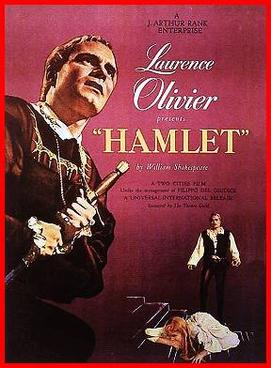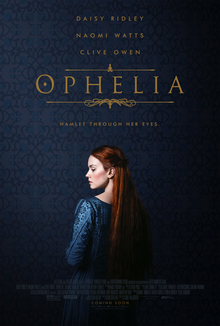
The Tragedy of Hamlet, Prince of Denmark, often shortened to Hamlet, is a tragedy written by William Shakespeare sometime between 1599 and 1601. It is Shakespeare's longest play. Set in Denmark, the play depicts Prince Hamlet and his attempts to exact revenge against his uncle, Claudius, who has murdered Hamlet's father in order to seize his throne and marry Hamlet's mother. Hamlet is considered among the "most powerful and influential tragedies in the English language", with a story capable of "seemingly endless retelling and adaptation by others". It is widely considered one of the greatest plays of all time. Three different early versions of the play are extant: the First Quarto ; the Second Quarto ; and the First Folio. Each version includes lines and passages missing from the others.

Hamlet is a 1948 British film adaptation of William Shakespeare's play of the same name, adapted and directed by and starring Laurence Olivier. Hamlet was Olivier's second film as director and the second of the three Shakespeare films that he directed. Hamlet was the first British film to win the Academy Award for Best Picture. It is the first sound film of the play in English.

Hamlet is a 1996 British epic historical drama film serving as an adaptation of William Shakespeare's play The Tragedy of Hamlet, Prince of Denmark, adapted and directed by Kenneth Branagh, who also stars as Prince Hamlet. The film also features Derek Jacobi as King Claudius, Julie Christie as Queen Gertrude, Kate Winslet as Ophelia, Michael Maloney as Laertes, Richard Briers as Polonius, and Nicholas Farrell as Horatio. Other cast members include Robin Williams, Gérard Depardieu, Jack Lemmon, Billy Crystal, Rufus Sewell, Charlton Heston, Richard Attenborough, Judi Dench, John Gielgud and Ken Dodd.

Hamlet, also known as Hamlet 2000, is a 2000 American drama film written and directed by Michael Almereyda, set in contemporary New York City, and based on the Shakespeare play of the same name. Ethan Hawke plays Hamlet as a film student, Kyle MacLachlan co-stars as Uncle Claudius, with Diane Venora as Gertrude, Liev Schreiber as Laertes, Julia Stiles as Ophelia, Steve Zahn as Rosencrantz, Bill Murray as Polonius, and Sam Shepard as Hamlet's father.

Polonius is a character in William Shakespeare's play Hamlet. He is the chief counsellor of the play's ultimate villain, Claudius, and the father of Laertes and Ophelia. Generally regarded as wrong in every judgment he makes over the course of the play, Polonius is described by William Hazlitt as a "sincere" father, but also "a busy-body, [who] is accordingly officious, garrulous, and impertinent". In Act II, Hamlet refers to Polonius as a "tedious old fool" and taunts him as a latter day "Jephtha".

Laertes is a character in William Shakespeare's play Hamlet. Laertes is Polonius' son and Ophelia's brother. In the final scene, he mortally stabs Hamlet with a poison-tipped sword to avenge the deaths of his father and sister, for which he blamed Hamlet. While dying of the same poison, he implicates King Claudius.

King Claudius is a fictional character and the main antagonist of William Shakespeare's tragedy Hamlet. He is the brother to King Hamlet, second husband to Gertrude and uncle and later stepfather to Prince Hamlet. He obtained the throne of Denmark by murdering his brother with poison and then marrying the late king's widow. He is loosely based on the Jutish chieftain Feng who appears in Chronicon Lethrense and in Saxo Grammaticus' Gesta Danorum. There has never been an actual Danish king of that name.

In William Shakespeare's play Hamlet, Gertrude is Hamlet's mother and Queen of Denmark. Her relationship with Hamlet is somewhat turbulent, since he resents her marrying her husband's brother Claudius after he murdered the king. Gertrude reveals no guilt in her marriage with Claudius after the recent murder of her husband, and Hamlet begins to show signs of jealousy towards Claudius. According to Hamlet, she scarcely mourned her husband's death before marrying Claudius.

Hamlet is a 1969 British tragedy period drama film. It is a film adaptation of Shakespeare's play Hamlet, starring Nicol Williamson as Prince Hamlet. It was directed by Tony Richardson and based on his own stage production at the Roundhouse theatre in London. The film also stars Anthony Hopkins as King Claudius, Judy Parfitt as Queen Gertrude, Marianne Faithfull as Ophelia, Mark Dignam as Polonius, Gordon Jackson as Horatio, and Michael Pennington as Laertes.

Prince Hamlet is the title character and protagonist of William Shakespeare's tragedy Hamlet (1599–1601). He is the Prince of Denmark, nephew to the usurping Claudius, and son of King Hamlet, the previous King of Denmark. At the beginning of the play, he is conflicted whether, and how, to avenge the murder of his father, and struggles with his own sanity along the way. By the end of the tragedy, Hamlet has caused the deaths of Polonius, Laertes, Claudius, and Rosencrantz and Guildenstern, two acquaintances of his from childhood. He is also indirectly involved in the deaths of his love Ophelia (drowning) and of his mother Gertrude.

Hamlet is a grand opera in five acts of 1868 by the French composer Ambroise Thomas, with a libretto by Michel Carré and Jules Barbier based on a French adaptation by Alexandre Dumas, père, and Paul Meurice of William Shakespeare's play Hamlet.
Over fifty films of William Shakespeare's Hamlet have been made since 1900. Seven post-war Hamlet films have had a theatrical release: Laurence Olivier's Hamlet of 1948; Grigori Kozintsev's 1964 Russian adaptation; a film of the John Gielgud-directed 1964 Broadway production, Richard Burton's Hamlet, which played limited engagements that same year; Tony Richardson's 1969 version featuring Nicol Williamson as Hamlet and Anthony Hopkins as Claudius; Franco Zeffirelli's 1990 version starring Mel Gibson; Kenneth Branagh's full-text 1996 version; and Michael Almereyda's 2000 modernisation, starring Ethan Hawke.
Hamlet at Elsinore is a 1964 television version of the c. 1600 play by William Shakespeare. Produced by the BBC in association with Danmarks Radio, it was shown in the U.S. on NET. Winning wide acclaim both for its performances and for being shot entirely at Helsingør, in the castle in which the play is set. It is the only version of the play to have actually been shot at Elsinore Castle. This programme was recorded and edited on video tape and not 'filmed'. The director was Philip Saville. It was the longest version of the play telecast in one evening up to that time, running nearly three hours. A 1947 telecast of the play had split it up into two ninety-minute halves over two weeks.
What follows is an overview of the main characters in William Shakespeare's Hamlet, followed by a list and summary of the minor characters from the play. Three different early versions of the play survive: known as the First Quarto ("Q1"), Second Quarto ("Q2"), and First Folio ("F1"), each has lines—and even scenes—missing in the others, and some character names vary.

Ophelia is a character in William Shakespeare's drama Hamlet (1599–1601). She is a young noblewoman of Denmark, the daughter of Polonius, sister of Laertes and potential wife of Prince Hamlet. Due to Hamlet's actions, Ophelia ultimately enters into a state of madness that leads to her drowning.

Hamlet is a 2009 television film adaptation of the Royal Shakespeare Company's 2008 modern-dress stage production of William Shakespeare's play of the same name, aired on BBC Two on 26 December 2009. It was broadcast by PBS' Great Performances in the United States on 28 April 2010.

Hamlet is a 1913 British silent drama film directed by Hay Plumb and starring Johnston Forbes-Robertson, Gertrude Elliott and Walter Ringham. It is an adaptation of the play Hamlet by William Shakespeare made by the Hepworth Company and based on the Drury Lane Theatre's 1913 staging of the work.

Ophelia is a 2018 historical drama film directed by Claire McCarthy and written by Semi Chellas about the character of the same name from William Shakespeare's play Hamlet. Based on the novel by Lisa Klein, the film follows the story of Hamlet from Ophelia's perspective. It stars Daisy Ridley in the title role, alongside Naomi Watts, Clive Owen, George MacKay, Tom Felton and Devon Terrell. The dialogue is in modern English.

Hamlet. XXI Century is a 2009 four-episode television miniseries by Yuri Kara. It is an adaptation and modernization of William Shakespeare's tragedy Hamlet.

Elsinore is a 2019 point-and-click adventure game developed and published by Golden Glitch for Windows, Linux, and macOS. The game follows the character of Ophelia from William Shakespeare's Hamlet. In Elsinore, Ophelia has a vision of the deaths of everyone in Elsinore Castle and relives the same four days again and again as she works to prevent the tragedy that will fall over everyone.


















